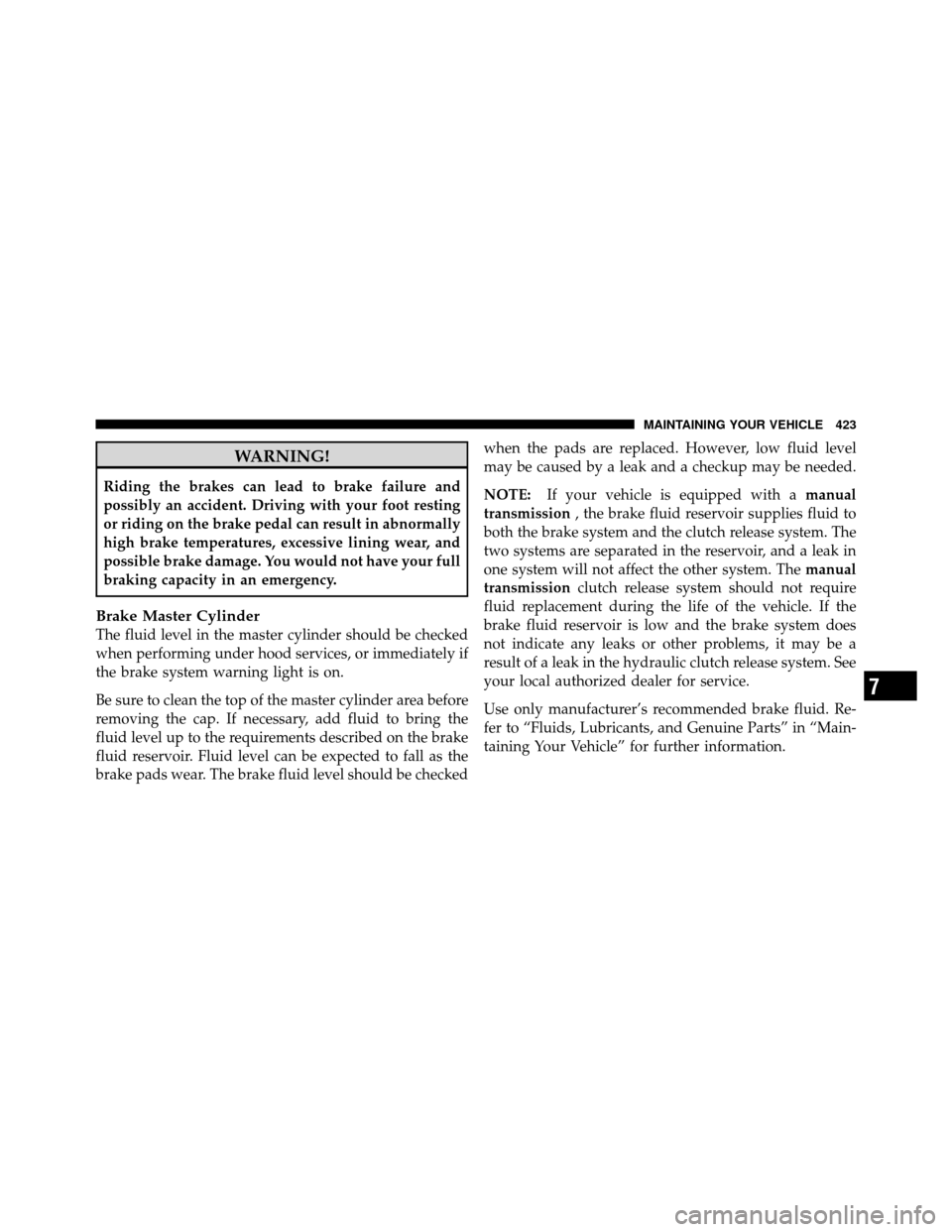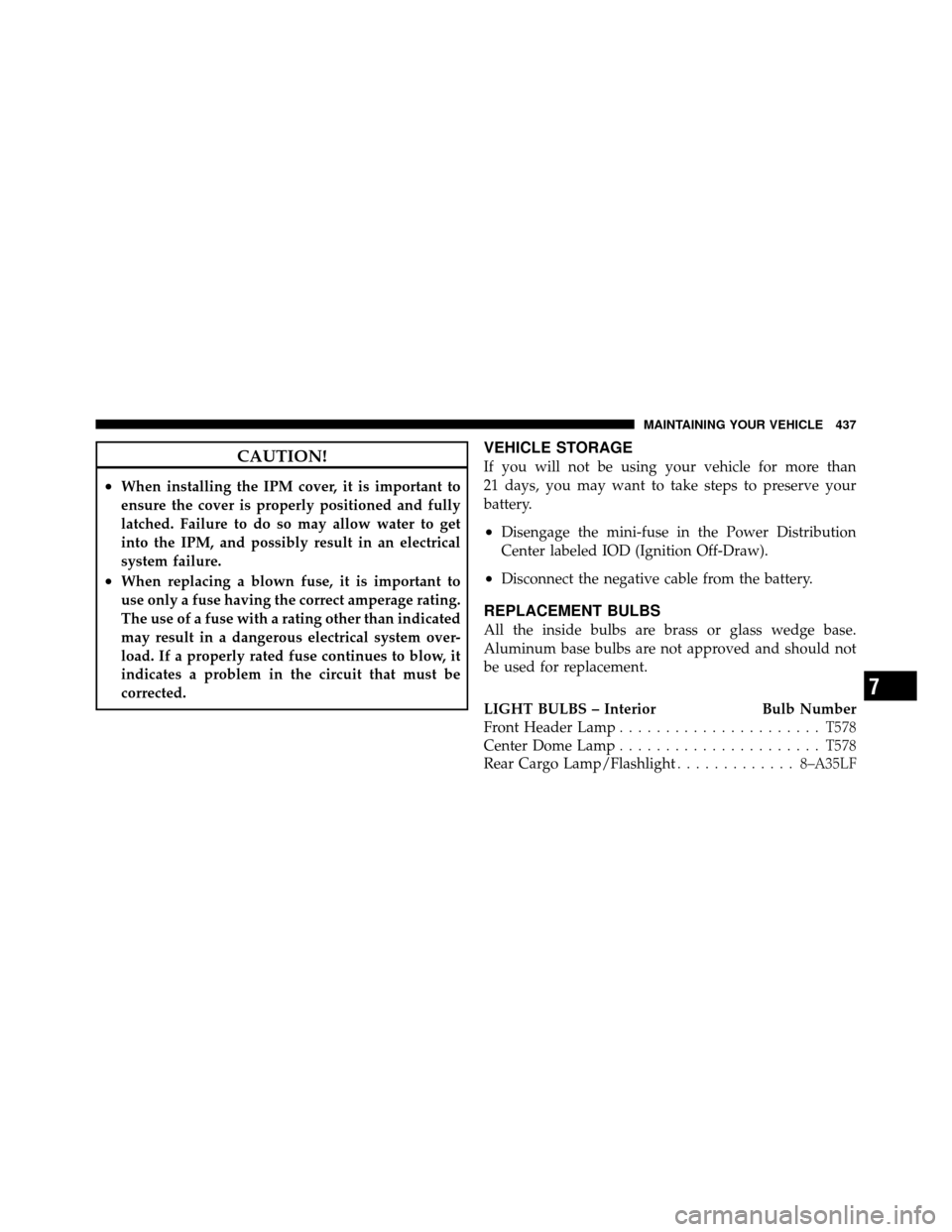Page 405 of 496

persists, the message will appear the next time the
vehicle is started. This might indicate a damaged cap. If
the problem is detected twice in a row, the system will
turn on the MIL. Resolving the problem will turn the MIL
light off.
EMISSIONS INSPECTION AND MAINTENANCE
PROGRAMS
In some localities, it may be a legal requirement to pass
an inspection of your vehicle’s emissions control system.
Failure to pass could prevent vehicle registration.For states that require an Inspection and Mainte-
nance (I/M), this check verifies the “Malfunction
Indicator Light (MIL)” is functioning and is not
on when the engine is running, and that the OBD II
system is ready for testing. Normally, the OBD II system will be ready. The OBD II
system may
notbe ready if your vehicle was recently
serviced, recently had a dead battery or a battery replace-
ment. If the OBD II system should be determined not
ready for the I/M test, your vehicle may fail the test.
Your vehicle has a simple ignition key-actuated test,
which you can use prior to going to the test station. To
check if your vehicle’s OBD II system is ready, you must
do the following:
1. Turn the ignition switch to the ON position, but do not
crank or start the engine.
2. If you crank or start the engine, you will have to start
this test over.
3. As soon as you turn the ignition switch to the ON
position, you will see the MIL symbol come on as part of
a normal bulb check.
404 MAINTAINING YOUR VEHICLE
Page 424 of 496

WARNING!
Riding the brakes can lead to brake failure and
possibly an accident. Driving with your foot resting
or riding on the brake pedal can result in abnormally
high brake temperatures, excessive lining wear, and
possible brake damage. You would not have your full
braking capacity in an emergency.
Brake Master Cylinder
The fluid level in the master cylinder should be checked
when performing under hood services, or immediately if
the brake system warning light is on.
Be sure to clean the top of the master cylinder area before
removing the cap. If necessary, add fluid to bring the
fluid level up to the requirements described on the brake
fluid reservoir. Fluid level can be expected to fall as the
brake pads wear. The brake fluid level should be checkedwhen the pads are replaced. However, low fluid level
may be caused by a leak and a checkup may be needed.
NOTE:
If your vehicle is equipped with a manual
transmission , the brake fluid reservoir supplies fluid to
both the brake system and the clutch release system. The
two systems are separated in the reservoir, and a leak in
one system will not affect the other system. The manual
transmission clutch release system should not require
fluid replacement during the life of the vehicle. If the
brake fluid reservoir is low and the brake system does
not indicate any leaks or other problems, it may be a
result of a leak in the hydraulic clutch release system. See
your local authorized dealer for service.
Use only manufacturer’s recommended brake fluid. Re-
fer to “Fluids, Lubricants, and Genuine Parts” in “Main-
taining Your Vehicle” for further information.
7
MAINTAINING YOUR VEHICLE 423
Page 432 of 496

•Do not use any harsh solvents or any other form of
protectants on Stain Repel products.
Interior Care
Use MOPAR�Total Clean or equivalent to clean fabric
upholstery and carpeting.
Use MOPAR� Total Clean or equivalent to clean vinyl
upholstery.
MOPAR� Total Clean or equivalent is specifically recom-
mended for leather upholstery.
Your leather upholstery can be best preserved by regular
cleaning with a damp, soft cloth. Small particles of dirt
can act as an abrasive and damage the leather upholstery
and should be removed promptly with a damp cloth.
Stubborn soils can be removed easily with a soft cloth
and MOPAR� Total Clean or equivalent. Care should be
taken to avoid soaking your leather upholstery with any
liquid. Please do not use polishes, oils, cleaning fluids, solvents, detergents, or ammonia based cleaners to clean
your leather upholstery. Application of a leather condi-
tioner is not required to maintain the original condition.WARNING!
Do not use volatile solvents for cleaning purposes.
Many are potentially flammable, and if used in
closed areas, they may cause respiratory harm.
Cleaning Headlights
Your vehicle has plastic headlights that are lighter and
less susceptible to stone breakage than glass headlights.
Plastic is not as scratch resistant as glass and, therefore,
different lens cleaning procedures must be followed.
To minimize the possibility of scratching the lenses and
reducing light output, avoid wiping with a dry cloth. To
remove road dirt, wash with a mild soap solution fol-
lowed by rinsing.
7
MAINTAINING YOUR VEHICLE 431
Page 436 of 496
Cavity CartridgeFuseMini-
Fuse Description
10 20 Amp
YellowCCN Power Locks/
Interior Lighting
11 15 Amp
Lt BluePower Outlet
12 20 Amp
YellowIgn Run/Acc Inverter
13 20 Amp
YellowPwr Run/Acc Outlet
RR/Dome Lamp/
Cigar Lighter
14 10 Amp
RedIOD CCN
15 40 Amp Green RAD Fan Relay Bat-
tery Feed
16 15 Amp
Lt BlueIGN Run/Acc Dome
Lamp/Sunroof/Rear
Wiper Motor/ACC
InverterCavity Cartridge
FuseMini-
Fuse Description
17 10 Amp
RedIOD Feed Mod-Wcm
18 40 Amp Green ASD Relay Contact
PWR Feed
19 20 Amp
YellowPWR Amp 1 & Amp
2 Feed
20 15 Amp
Lt BlueIOD Feed Radio
21 10 Amp
RedIOD Feed Intrus
Mod/Siren – If
Equipped
22 10 Amp
RedIGN RUN Heat/AC/
Compass Sensor
23 15 Amp
Lt BlueENG ASD Relay Feed
3
24 15 Amp
Lt BluePower Sunroof Feed –
If Equipped
7
MAINTAINING YOUR VEHICLE 435
Page 438 of 496

CAUTION!
•When installing the IPM cover, it is important to
ensure the cover is properly positioned and fully
latched. Failure to do so may allow water to get
into the IPM, and possibly result in an electrical
system failure.
•When replacing a blown fuse, it is important to
use only a fuse having the correct amperage rating.
The use of a fuse with a rating other than indicated
may result in a dangerous electrical system over-
load. If a properly rated fuse continues to blow, it
indicates a problem in the circuit that must be
corrected.
VEHICLE STORAGE
If you will not be using your vehicle for more than
21 days, you may want to take steps to preserve your
battery.
•Disengage the mini-fuse in the Power Distribution
Center labeled IOD (Ignition Off-Draw).
•Disconnect the negative cable from the battery.
REPLACEMENT BULBS
All the inside bulbs are brass or glass wedge base.
Aluminum base bulbs are not approved and should not
be used for replacement.
LIGHT BULBS – Interior Bulb Number
Front Header Lamp...................... T578
Center Dome Lamp ...................... T578
Rear Cargo Lamp/Flashlight .............8–A35LF
7
MAINTAINING YOUR VEHICLE 437
Page 439 of 496
LIGHTS BULBS – ExteriorBulb No.
Low Beam/High Beam Headlamp ............ H13
Front Park/Turn Signal/Side Marker Lamp . . . 3757KA
Front Fog Lamp ...................... PSX24W
Center High Mounted Stop Lamp (CHMSL) . . LED As-
sembly
Rear Tail/Turn/Stop Lamp .................3157
Backup Lamp ..................... W16W (921)
License Lamp .......................... W5WBULB REPLACEMENT
Headlamps
1. Raise the hood and locate the connector behind the
headlamp.
438 MAINTAINING YOUR VEHICLE
Page 442 of 496
Fog Lamps
See your authorized dealer for replacement.
Tail Lamps, Rear Turn Signals and Backup
Lamps
1. Remove the two push-pins from the taillamp housing.
2. Grasp the taillamp and pull firmly to disengage the
light from the aperture panel.
3. Twist and remove socket from the light.
4. Remove bulb from socket and replace.
License Lamps
1. Use a screw driver to gently pry against the side of the
snap tab to remove the lamp from the liftgate.
7
MAINTAINING YOUR VEHICLE 441
Page 443 of 496
2. Rotate the socket 1/4 turn counterclockwise.
3. Pull the bulb from the socket.
Center High-Mounted Stoplamp
Light is an LED assembly. See your authorized dealer for
replacement.
442 MAINTAINING YOUR VEHICLE